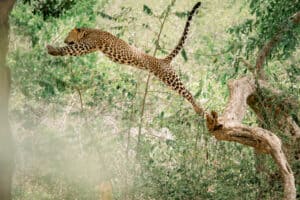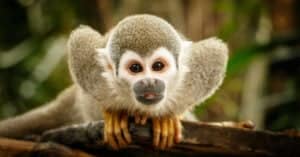Old World monkeys are primates that are indigenous to Africa and Asia. Several features distinguish them from New World monkeys, such as their larger size, more complex social structure, and longer snouts. Old World monkeys include species such as macaques, baboons, and langurs.
While Old World monkeys inhabit Africa and Asia, there is evidence to suggest that their true origins are in Africa. The basis of this belief is that most Old World monkey species live in Africa. Also, the African species tend to be more closely related to each other than to Asian species.
Old World monkeys’ social structures comprise groups of multiple families, often including both males and females. In contrast, New World monkeys typically build smaller groups consisting of a single-family unit. Discover 10 of the Old World monkey types below.
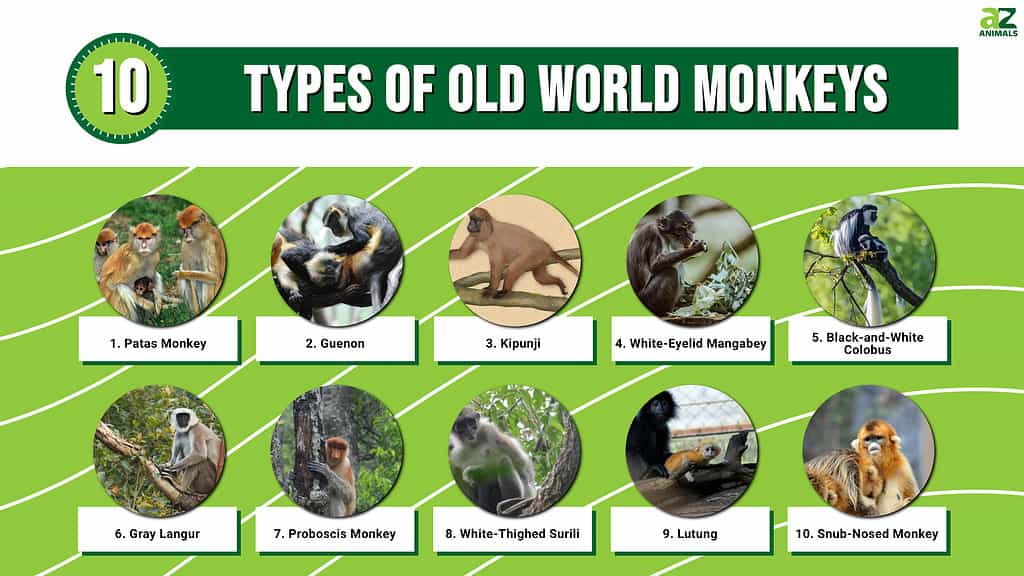
1. Patas Monkey
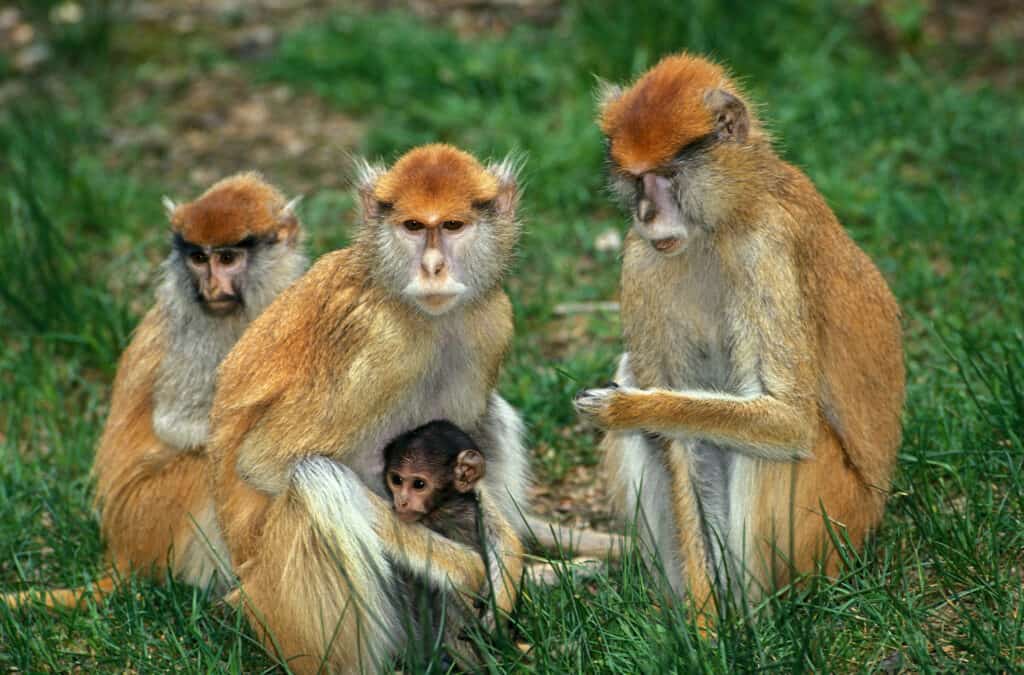
Patas monkeys are social animals that live in groups of up to 30 individuals.
©iStock.com/slowmotiongli
The patas monkey is a species of primate in the family Cercopithecidae. The name “patas” derives from Spanish and Portuguese words for “paw,” referring to the long, powerful hind legs of this animal which it uses for running. Patas monkeys are found in vast expanses across West, Central, and East Africa.
The patas monkey has a long, powerful tail for balance. A short, reddish-brown fur covers its body, while black hair surrounds its eyes. Patas monkeys grow to a size similar to an ordinary house cat and generally weigh between 6.6 and 19.8 pounds. However, males can weigh up to 28 pounds.
The diet of the patas monkeys mainly consists of grasses, fruits, and insects. Patas monkeys are social animals that live in groups of up to 30 individuals. They are also very active, spending most of the day running and climbing trees. Eagles and snakes are the most prevalent threat to these primates that fall into the least concern category on the IUCN Red List. However, the species is declining in some areas due to habitat loss and hunting.
2. Guenon
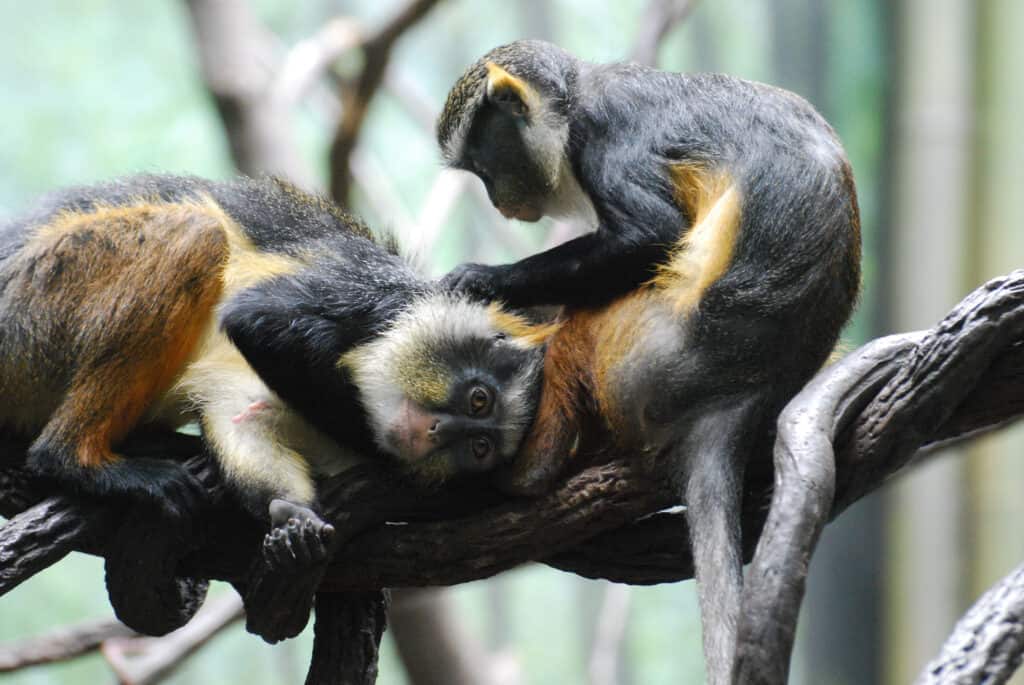
Guenons are Old World monkeys known for their multi-colored coats.
©iStock.com/DejaVu Designs
The guenon, also known as the Cercopithecine, is a species of Old World monkeys that include more than 100 different members. This primate inhabits all environments throughout Africa and Asia and ranges in size from just over 4 pounds to around 40 pounds. Guenons are identifiable by their long tails, which help them balance when leaping through the trees.
Their diet comprises mainly fruit, but they will also eat leaves, insects, and small mammals. Guenons are highly social animals, living in troops of up to 40 individuals. They are also quite vocal, using a combination of calls and sounds to communicate.
Guenons are perhaps best known for their distinctive coloration. Many species have bright, multicolored coats, which help them stand out in the dense foliage of their forest homes. While they are beautiful animals, guenons are also incredibly aggressive.
3. Kipunji

Kipunjis, which scientists first discovered in 2003, are also known as highland mangabeys.
©Zina Deretsky, National Science Foundation / Public domain, via Wikimedia Commons – License
Kipunji (Rungwecebus kipunji) is an Old World monkey species endemic to the southern highlands of Tanzania. Scientists first discovered the kipunji in 2003, and it is only one of two species in the genus Rungwecebus. The other is the closely related sanje crested mangabey (Rungwecebus sanjei) that dwells in the Udzungwa Mountains of Tanzania.
The kipunji is known as highland mangabeys. It is a large primate with dark brown or black fur and long tails. Adults weigh between 20 and 40 pounds, with the males weighing more than the females. Kipunji monkeys have long faces with prominent cheek pads and small eyes. However, their most distinctive feature is the crest of hair that runs from the tops of their heads to their tail base.
They live in montane forests at elevations of 4,900 to 9,500 feet. Family troops consist of up to 30 individuals: females, their young, and a few adult males. Kipunjis are predominantly arboreal, spending most of their time in the trees. Their diet comprises fruits, leaves, and insects primarily.
Kipunji is listed as endangered on the IUCN Red List and enjoys the protection of Tanzanian law. However, enforcement of these laws is weak, and people still hunt them for food and sale as pets. As a result, only an estimated 1,500 Kipunji Old World monkeys remain in the wild.
4. White-Eyelid Mangabey
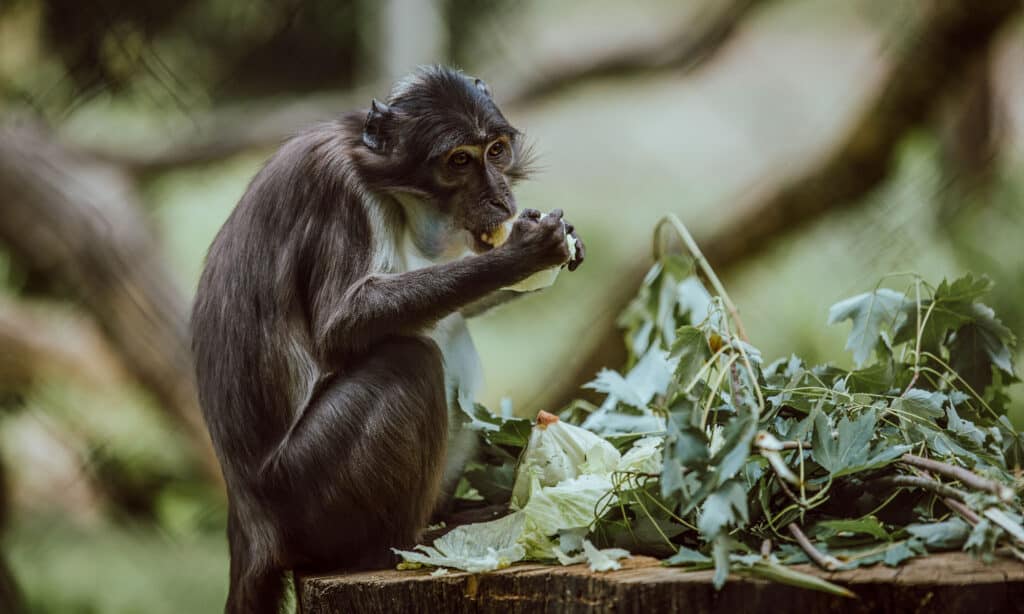
White-eyelid mangabeys, which have a white ring around their eyes, primarily eat fruit.
©ShutterSparrow/Shutterstock.com
The white-eyelid mangabey (Cercocebus atys) is a species of primate in the family Cercopithecidae. The mangabey is endemic to Central and West Africa.
White-eyelid mangabeys are medium-size with an overall grayish coat. Their faces are black, with a distinctive white stripe running from the base of the ear down to the mouth. These primates also have a white ring around their eyes. Males and females are similar in size and appearance. However, males typically weigh between 15 and 20 pounds, while females weigh between 11 and 13 pounds.
White-eyelid mangabeys are frugivores, meaning that their diet consists primarily of fruit. However, these monkeys also eat leaves, seeds, and insects occasionally. In addition, this primate is an opportunistic feeder, so it takes advantage of whatever food source is available.
The white-eyelid mangabey is a social animal living in large groups of up to 30 individuals. These groups typically consist of females who are related and their offspring. Males will generally leave their birth group when they reach sexual maturity and join a bunch of unrelated males.
White-eyelid mangabeys are an endangered species. People hunt these primates for their meat, which is a delicacy in some parts of Africa. But, unfortunately, people also kill it for its skin, which they use to make drums and other musical instruments.
5. Black-and-White Colobus
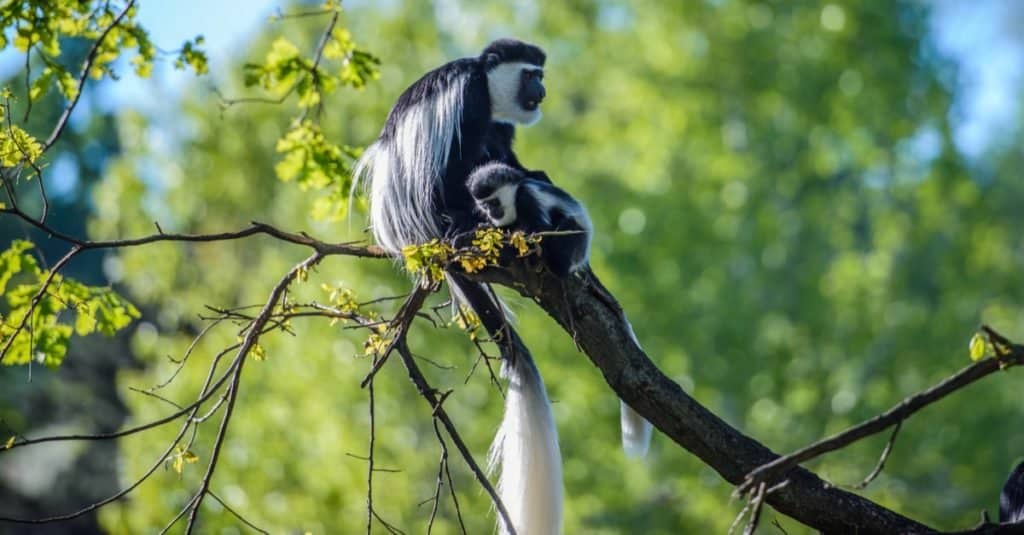
Adult black-and-white colobus monkeys have long, white hair on their shoulders and back.
©red-feniks/Shutterstock.com
Black-and-white colobuses (Colobus guereza) belong to the Colobidae family. You find this species in Angola, Cameroon, and the Central African Republic, all through to the Congo, Ivory Coast, and Equatorial Guinea. Its natural environment includes the subtropical or tropical moist lowland forests or swamps.
These primates’ name comes from their striking black and white coloration. The adults have long, white hair on their shoulders and back, while black fur covers the rest of their bodies. A distinctive crest of white hair on their head is yet another physical feature setting them apart from other primates. Juveniles are generally darker in color, with less distinct coloring than adults.
Adult black-and-white colobus monkeys typically weigh between 15 and 32 pounds. They have a body length of 17 to 28 inches and a tail length of 20 to 40 inches.
These primates are folivores, so their diet consists primarily of leaves. However, they will also eat fruits, flowers, seeds, and bark when leaves are unavailable. And while a diet of leaves may sound monotonous, these primates consume leaves from more than 100 different species of plants, making for an incredibly varied diet.
Black-and-white colobuses live in troops of three to 15 individuals. The oldest male with the most experience leads the troop. These monkeys also have a reputation as being acrobatic. So, they are proficient climbers and spend most of their time in the trees. They are also excellent swimmers.
Black-and-white colobus monkeys are not currently on the list of endangered species.
6. Gray Langur
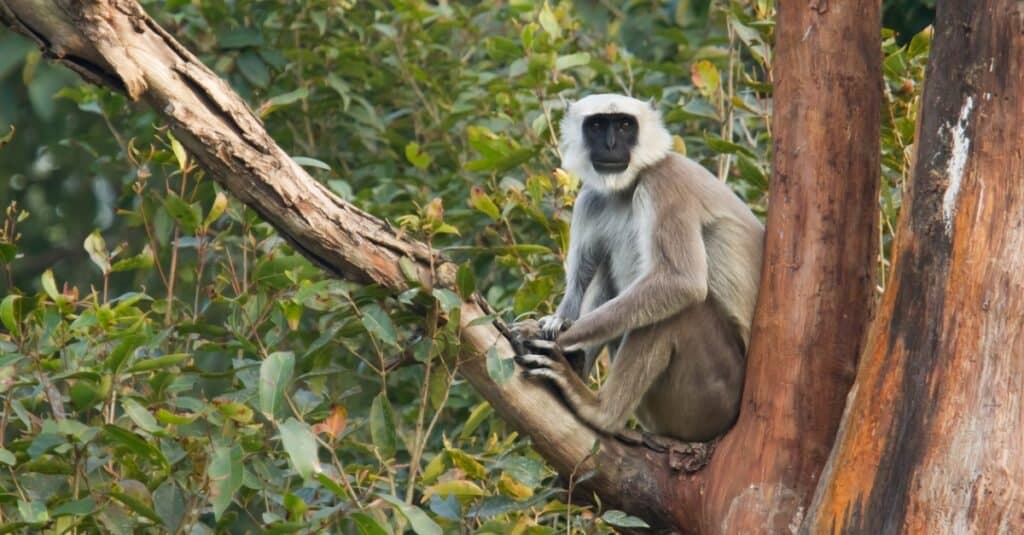
Gray langurs are a type of Old World monkey with gray coats but hands, ears, and fingers that are also primarily hairless.
©iStock.com/Utopia_88
The gray langur is a species of Old World monkeys native to the Indian subcontinent that people have since introduced to Sri Lanka. The IUCN lists it as a primate of least concern.
Gray langurs are large with long tails that can be twice the length of their body. It has a dark gray coat, which is lighter on its undersides. Their faces are black and hairless, surrounded by a gray-white band. Notably, their hands, ears, and fingers are also primarily bald.
Both genders are similar in appearance, although the males are generally larger than the females. The average weight of male gray langurs is 40 pounds and 24 pounds for females. Their head-and-body length grows between 20 and 31 inches, with tails between 27 and 40 inches.
This langur is herbivorous, feeding mainly on leaves, flowers, fruits, and seeds. It is also arboreal, spending most of its life in the tree tops. Additionally, it is diurnal, being active during the day and sleeping at night.
7. Proboscis Monkey
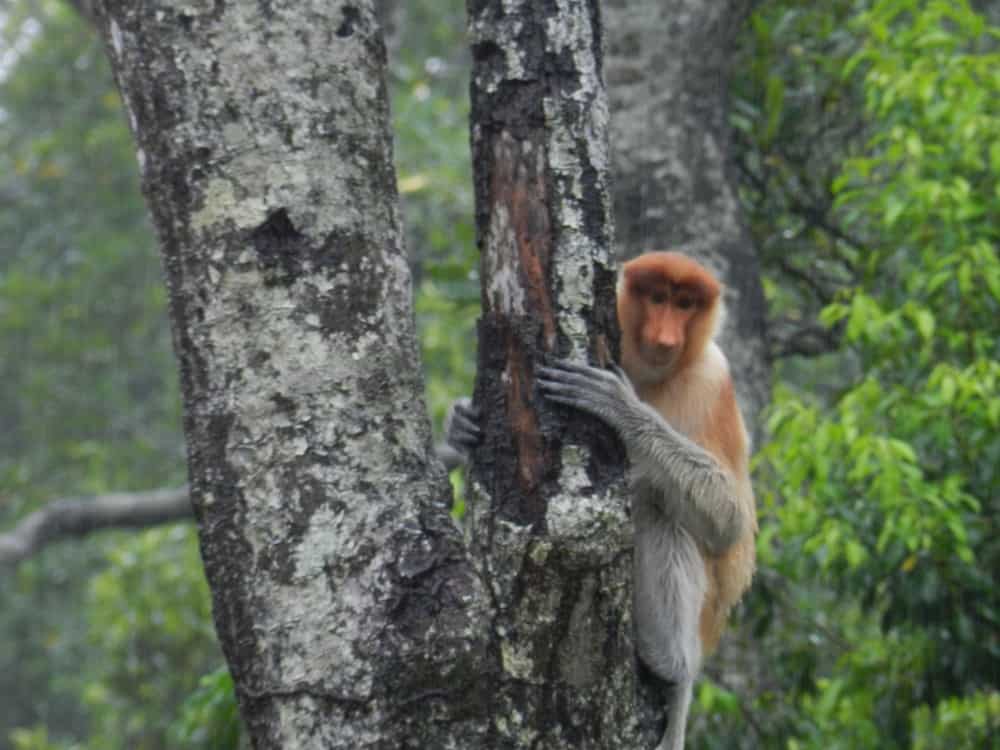
Proboscis monkeys are recognizable by their long, bulbous noses.
©Millie Bond – Copyright A-Z Animals
Proboscis monkeys are another Old World species endemic to the island of Borneo. They are among the biggest arboreal monkey species and the largest primates in Asia.
These monkeys are readily identifiable by their long, bulbous nose, which scientists believe is an adaptation to the humid climate of their tropical habitat. In addition, males have significantly larger bodies and noses than females. Proboscis monkeys grow to between 26 and 30 inches in length and weigh up to 50 pounds.
Proboscis monkeys are arboreal, so they live most of their lives on the tree tops. Additionally, they are proficient swimmers that can dive to depths of 30 feet in search of food. Moreover, these Old World monkeys are omnivorous, eating plants and animals.
A single male leads large troops consisting of females and their young. Males leave the troop when they reach adulthood and live solitary lives until they can take over a troop of their own.
Proboscis monkeys are endangered because their numbers are rapidly declining. Conservation efforts are ongoing to help protect the species and its habitat.
8. White-Thighed Surili
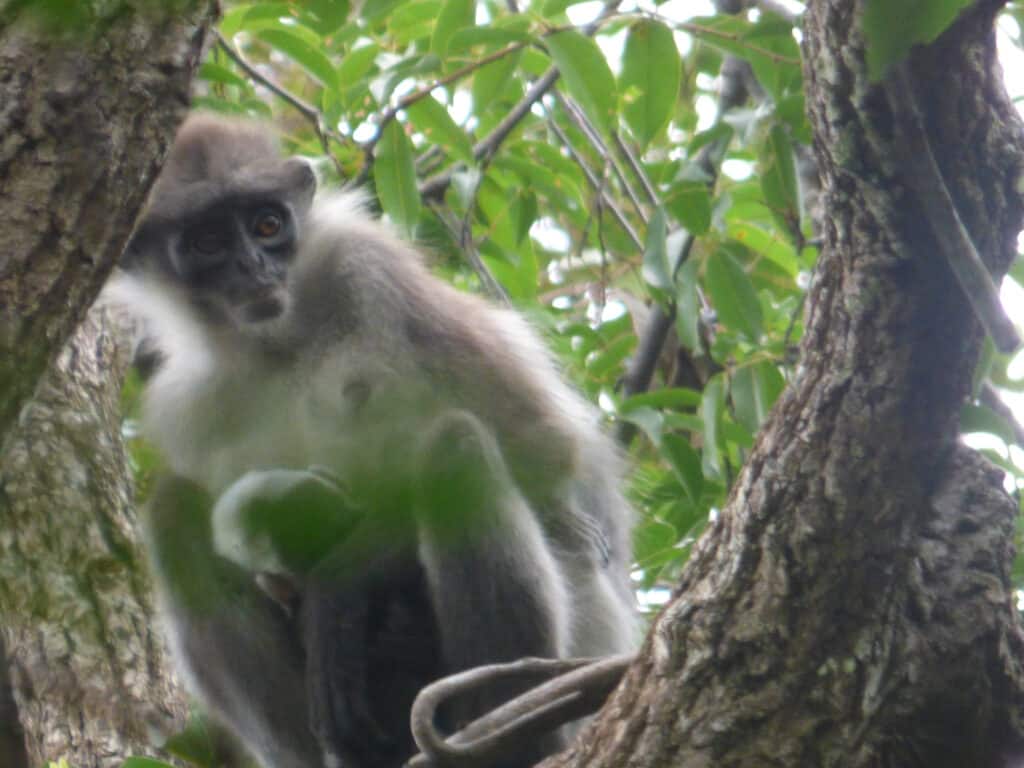
The white-thighed surili is a type of Old World monkey with a reddish-brown coat and white hair on its thighs.
©iStock.com/Eugene Prewitt
White-thighed surili (Presbytis siamensis) is a species of primates in the family Cercopithecidae. They are indigenous to Southeast Asia. They are also known as the banded leaf monkey and the spectacled langur. White-thighed surili lives in submontane forests, favoring primary and secondary rainforests, swamp forests, mangrove forests, and rubber tree plantations. Surili are arboreal and diurnal.
These monkeys have a reddish-brown coat with white hair on their thighs. There are no physical distinctions in coloring between sexes.
The white-thighed surili is a type of Old World monkey that is one of the largest members of the Presbytis. With a head-body length of approximately 20 inches, this primate weighs from 11 to 14.8 pounds. Surili is about the same size as a human child. Its favorite foods consist primarily of fruits, leaves, and insects.
Surili is an endangered species protected by law in Indonesia and Malaysia.
9. Lutung
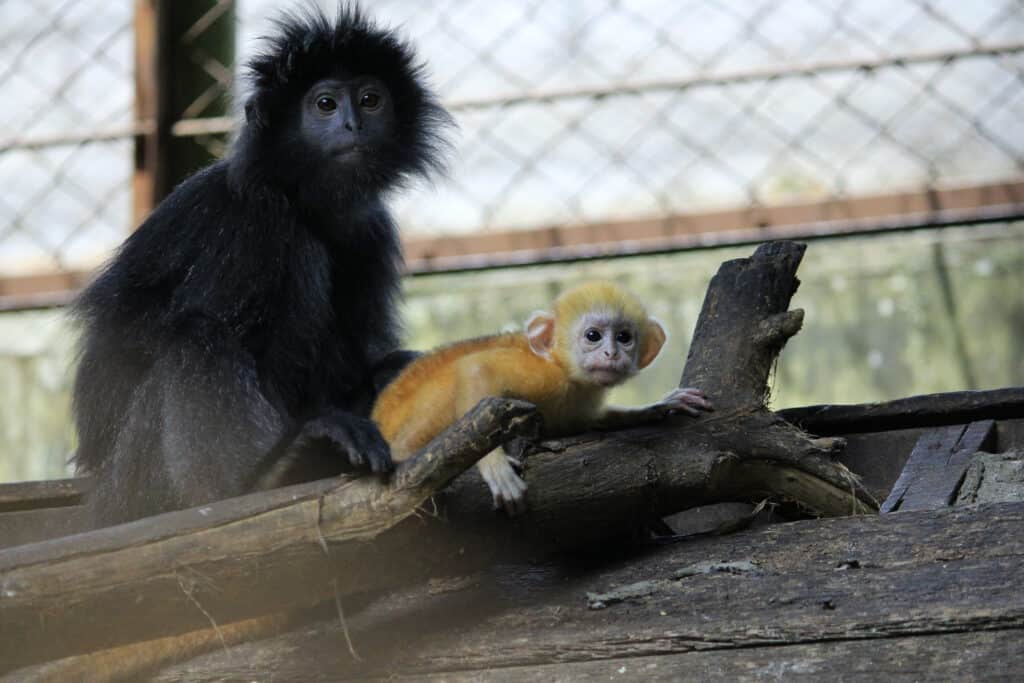
Lutungs are small, with males reaching a maximum height of around 3.94 feet and females about 3.2 feet.
©iStock.com/bari paramarta
Lutung is a species of ape that is indigenous to Indonesia. They live on the Java, Sumatra, and Borneo islands and inhabit parts of Malaysia and Thailand. Lutang are also known as the Javan lutung.
These apes are small, weighing up to 15 pounds with males reaching a maximum height of around 3.94 feet and females around 3.2 feet. Their fur is thick and black, and they have long tails that improve their balance. Lutungs are Old World monkeys that are mainly active during the day, are proficient climbers, and can leap up to 9.8 feet between trees. Their primary food consists of fruits, leaves, and insects. These monkeys live in groups of up to 20 individuals.
10. Snub-Nosed Monkey
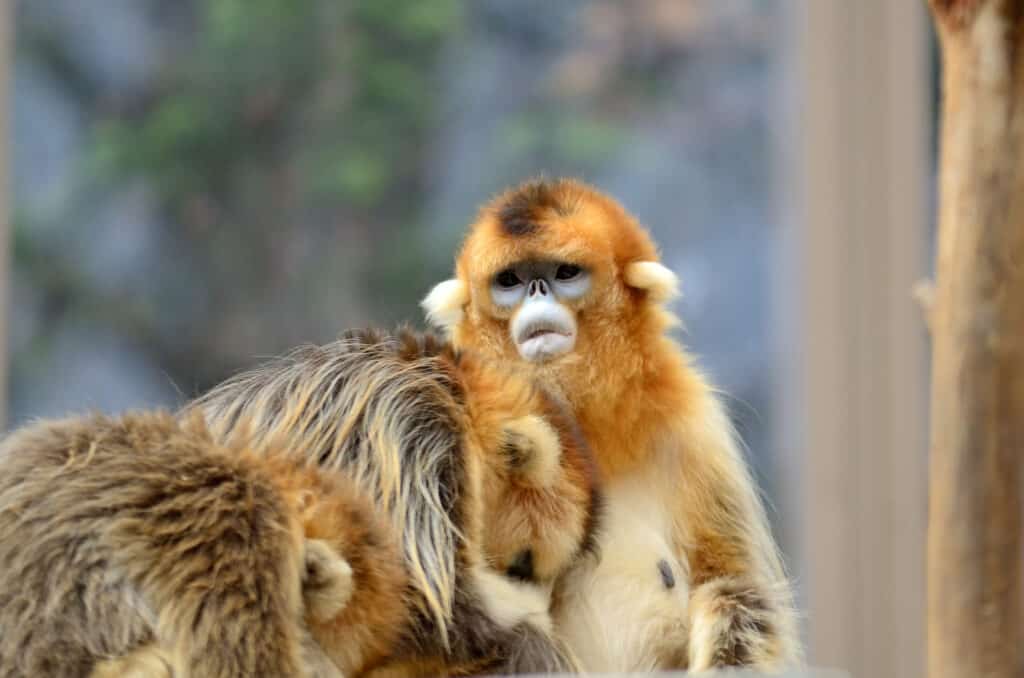
Snub-nosed primates are Old World monkeys distinguished by their short, upturned noses.
©iStock.com/Cn0ra
The snub-nosed monkey is a primate found in the forests of Central and Southeast Asia. The snub-nosed monkey is distinguished by its short, upturned nose. They are medium-sized, growing to 20 and 26 inches long and weighing 27 to 44 pounds.
Snub-nosed monkeys are intelligent and social animals. They live in troops of up to 200 individuals with a well-developed communication system. The snub-nosed monkey is also a skilled tree-climber and can leap up to 50 feet from the ground. This primate is a shy and elusive animal and is problematic to observe in the wild. However, authorities have established several sanctuaries and reserves to protect the snub-nosed monkey and its habitat.
Unfortunately, the snub-nosed monkey is an endangered species, with fewer and fewer individuals left every year across all four species.
Summary of 10 Types of Old World Monkeys
Here’s a recap of the 10 Old World monkeys that we took a look at.
| Number | Monkey | Weight | Range |
|---|---|---|---|
| 1 | Patas Monkey | 6.6-19.8 pounds; males can be up to 28 pounds | West, Central, and East Africa |
| 2 | Guenon | 4-40 pounds | Throughout Africa and Asia |
| 3 | Kipunji | 20-40 pounds; males weigh more females | Endemic to southern highlands of Tanzania |
| 4 | White-Eyelid Mangabey | Males: 15-20 pounds; females: 11-13 pounds | Endemic to Central and West Africa |
| 5 | Black-and-White Colobus | 15-32 pounds | Angola, Cameroon, and the Central African Republic, all through to the Congo, Ivory Coast, and Equatorial Guinea |
| 6 | Gray Langur | Males: 40 pounds; females: 24 pounds | Native to the Indian subcontinent; introduced to Sri Lanka |
| 7 | Proboscis Monkey | Up to 50 pounds | Endemic to Borneo |
| 8 | White-Thighed Surili | 11-14.8 pounds | Indigenous to Southeast Asia |
| 9 | Lutung | Up to 15 pounds | Java, Sumatra, and Borneo islands; parts of Malaysia and Thailand |
| 10 |
The photo featured at the top of this post is © iStock.com/Utopia_88
Thank you for reading! Have some feedback for us? Contact the AZ Animals editorial team.




